Options are among the most versatile instruments in the financial markets, enabling traders and investors to manage risk, generate income, or speculate on price movements in a targeted manner. Yet, for many newcomers, the world of options can be daunting. There are specific jargon, multiple moving pieces (strike prices, premiums, expirations), and a wide range of strategies—some defensive, others aggressive. It’s easy to get lost if you dive in without guidance.
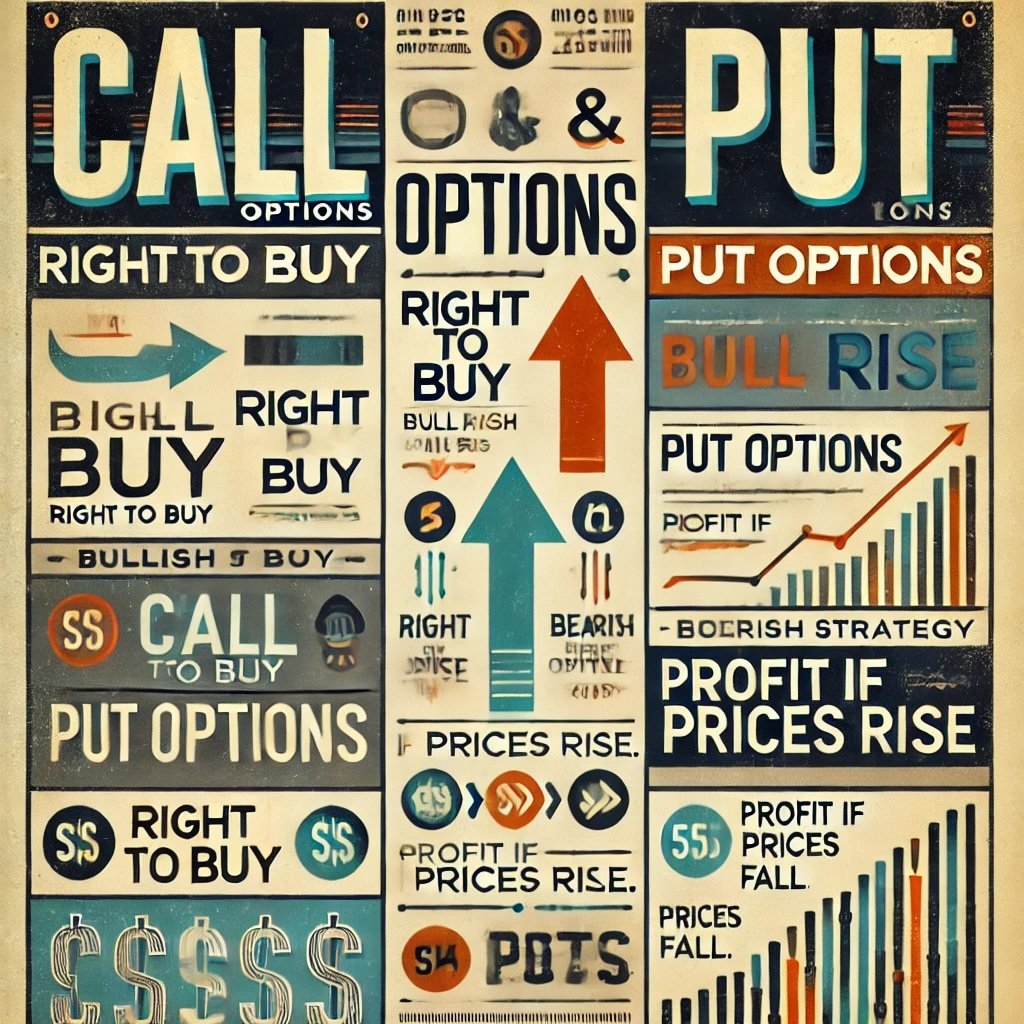
Options can be confusing.
This guide aims to shine a bright light on the two fundamental option contract types: calls and puts. Before you can master advanced option spreads or complex multi-leg setups, you should have a clear understanding of how a simple call or put functions. Once you know these basics, you can more confidently assess whether an option trade suits your market outlook, risk tolerance, and investing timeline.
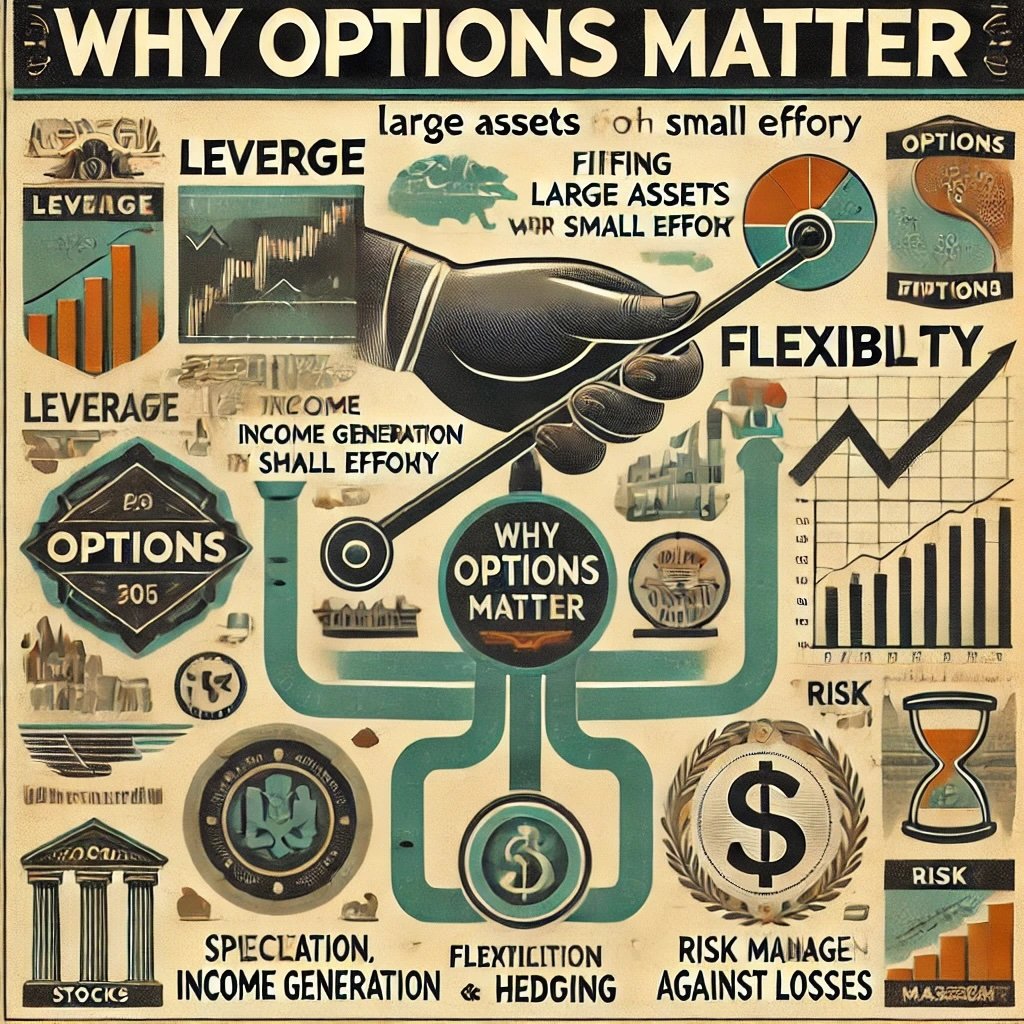
Why Options Matter
Options differ from stocks or bonds in that they’re contracts providing certain rights and obligations about buying or selling an underlying asset (like a company’s shares, an index, or a commodity) at a specified price by a certain date. This is powerful because:
- Leverage: You can control a larger amount of the underlying asset with a relatively small premium, meaning potential gains or losses can be magnified.
- Flexibility: Options can be used for speculation, income generation, or hedging existing positions, depending on how you structure them.
- Risk Management: They allow you to define or limit the maximum risk for your trades, if used wisely.
In short, options represent a toolkit for shaping your exposure to market moves, whether bullish, bearish, or even sideways. But the core building blocks remain call and put contracts. Calls typically reflect a bullish (or upward) sentiment, while puts typically reflect a bearish (or downward) sentiment, though the variety of ways to incorporate them into your portfolio extends far beyond mere directional bets.
![]()
Structure of This Guide
We will start with a deep dive into call options: how they’re structured, the rights they grant, and an example scenario illustrating their payoff profile. Next, we’ll explore put options in a similar manner. After that, we’ll compare calls vs. puts to clarify their contrasting risk-reward dynamics and typical usage. Finally, we’ll outline some of the more practical applications for both calls and puts—speculation, hedging, or generating income—before wrapping up with a concluding perspective.
Let’s begin with calls.
![]()
What Is a Call Option?
A call option grants the buyer the right (but not the obligation) to buy an underlying asset at a specific strike price on or before a defined expiration date. By paying a premium upfront, the buyer secures this right, while the seller (or writer) of the call option receives that premium. If the market price of the underlying rises significantly above the strike, the call buyer can exercise the option—buying the asset at the strike price—potentially flipping it in the market for a profit, or simply cash-settling the difference if the option is structured that way.
Call = right to buy.
Key Features
- Strike Price: The agreed-upon level at which the buyer can purchase the underlying. If the underlying’s market price stays below this strike, the call may remain out of the money and expire worthless. If the market price climbs above the strike, the call becomes more valuable.
- Expiration Date: The last day on which the option can be exercised. Some markets use American-style options (exercise anytime up to expiration), while others use European-style (exercise only on the expiration date). In practice, many traders close positions before expiration by selling the option back into the market.
- Premium: The cost of the option. Determined by factors like the current underlying price, strike, implied volatility, time until expiration, and interest rates. The buyer’s potential loss is limited to this premium.
- Intrinsic vs. Extrinsic Value: If the market price is above the strike, the call has intrinsic value (the difference between current price and strike). Anything beyond that is extrinsic value, partly reflective of time to expiration and implied volatility.
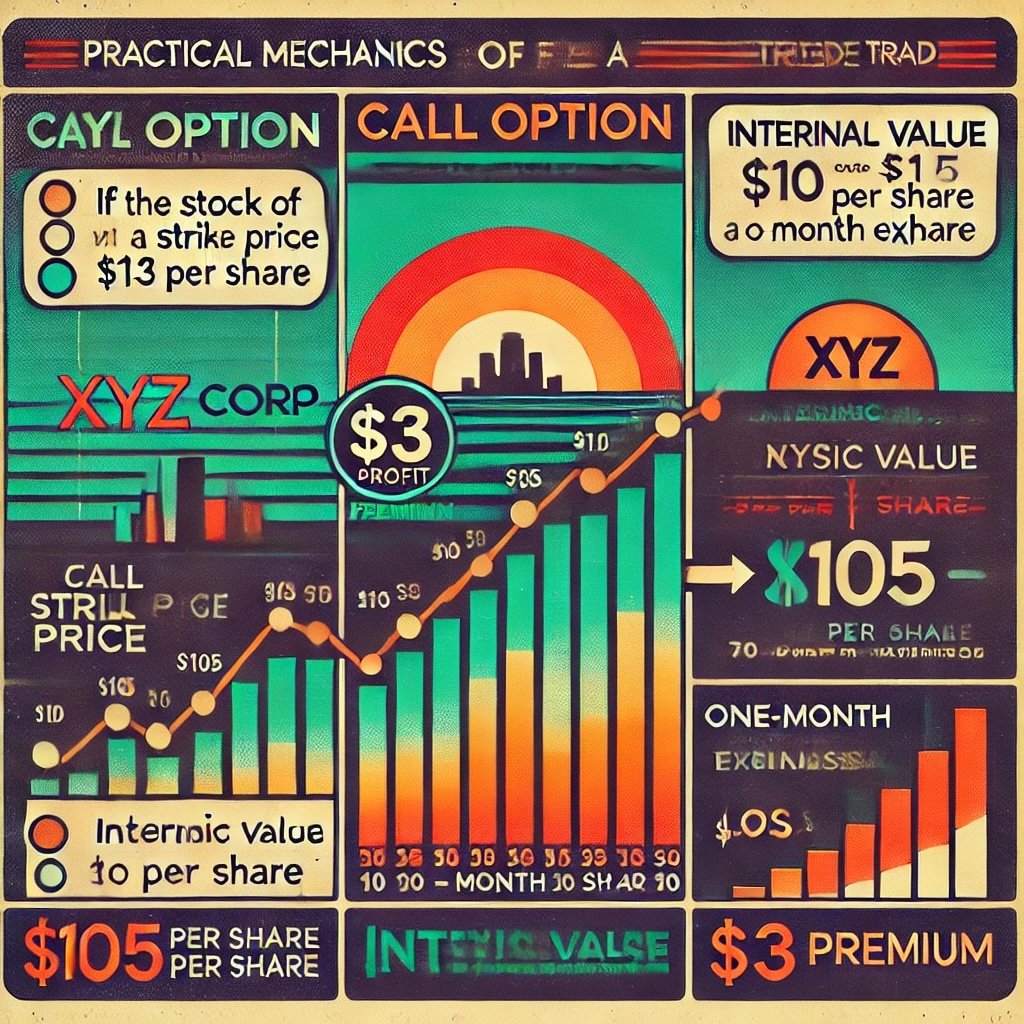
How It Works in Practice
Imagine a stock—XYZ Corp.—currently trading at $100. You buy a call with a $105 strike that expires in one month, paying a $3 premium per contract (contracts typically represent 100 shares each). If, by expiration, XYZ shares trade at $115, the call’s intrinsic value is $10 per share ($115 minus the $105 strike). You effectively paid $3 to access an upside of $10, meaning your net profit is $7 per share (or $700 per contract), minus any commissions. On the other hand, if XYZ finishes below $105, the option could expire worthless, leaving you with a loss of the $3 premium.
Simple but powerful.
When to Use Call Options
- Bullish Outlook: If you believe a stock or index will go up, buying a call can yield outsized returns for smaller initial capital.
- Limited Capital, High Upside: If you don’t want to tie up the funds to buy 100 shares at $100 each, paying a premium for a call offers you leverage.
- Capped Risk: Your maximum loss is the premium if the bullish thesis fails.
However, calls can degrade in value from time decay—each day that passes without the underlying moving your way chips away at the option’s extrinsic value. Also, if implied volatility drops, your call might lose value even if the underlying’s price doesn’t move significantly. So while calls provide a structured route for upside speculation, you must remain vigilant about the option’s time and volatility dynamics.
Pros of Call Options
- Limited Downside Risk: You can’t lose more than the premium.
- High Upside Potential: If the stock soars well above the strike, the call’s gains can be substantial relative to your premium.
- Versatility: You can close the option (take profits or cut losses) before expiration by selling it in the options market.
Cons of Call Options
- Time-Decay Pressure: If the underlying drifts sideways or rises too slowly, the call’s value may still erode as expiration nears.
- Implied Volatility Risk: If volatility declines, the option price might sag, even if the stock remains flat.
- Short Lifespan: Options expire, so your bullish view must materialize within a limited window.
Use calls wisely for bullish plays.
Now that we’ve covered calls thoroughly, let’s shift to the other side of the coin: put options, which revolve around selling the underlying.
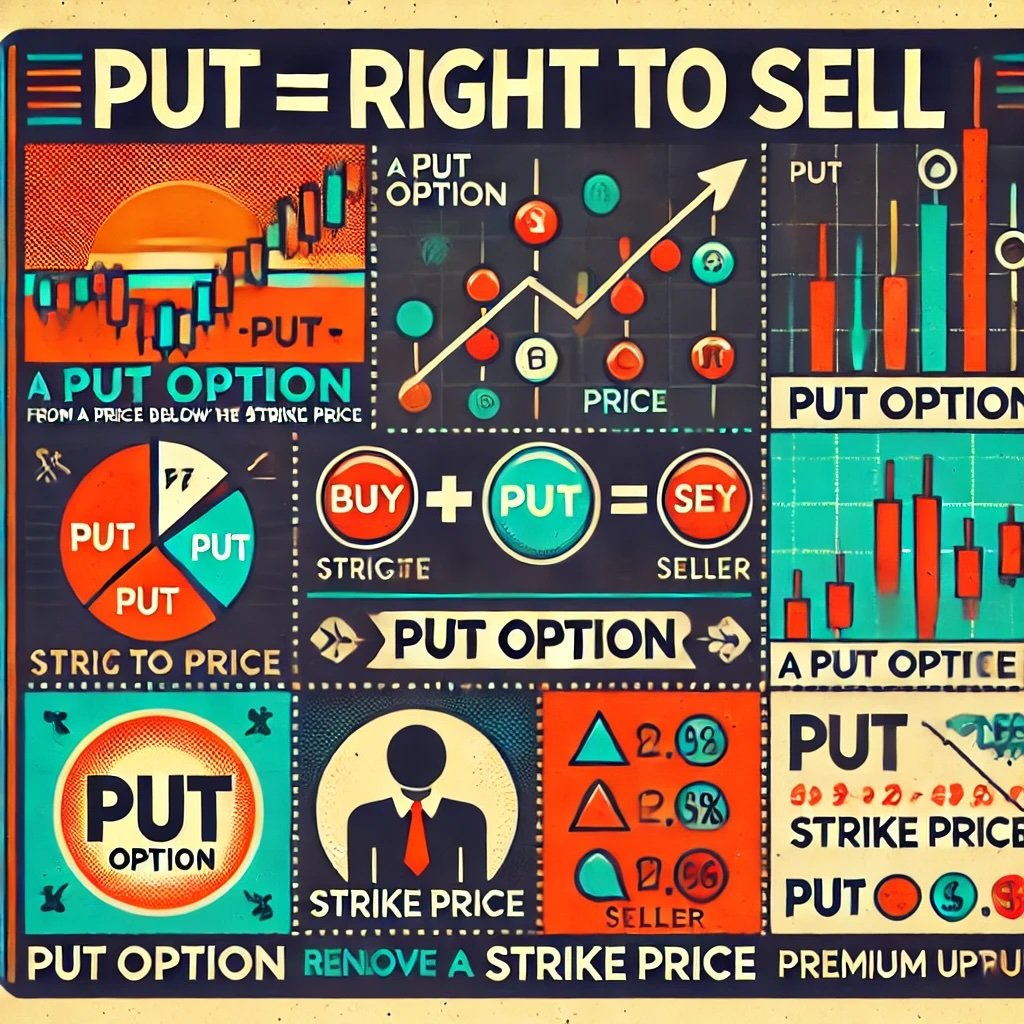
What Is a Put Option?
A put option grants the buyer the right (but again, not the obligation) to sell an underlying asset at a specified strike price on or before a certain expiration date. The buyer pays a premium to secure this right, while the option writer receives that premium. If the underlying asset’s market price plunges far below the strike, the put buyer can gain significantly, since they can essentially sell the asset at a higher strike price than the open market offers.
Put = right to sell.
Key Features
- Strike Price: The set level at which the put buyer can sell the underlying if desired. If the market price never dips below that strike, the put may remain out-of-the-money and worthless.
- Expiration Date: Similar to calls, you typically have until this date to exercise or sell your put.
- Premium: The amount the put buyer pays. This also represents the maximum loss for them if the market fails to decline sufficiently.
- Intrinsic and Extrinsic Value: A put with a strike above the underlying’s current market price can have intrinsic value (difference between strike and underlying price). The rest is extrinsic, reflecting time and volatility.
How It Works in Practice
Suppose a stock—ABC Inc.—trades at $50. You buy a put option with a $45 strike, expiring in two months, paying a $2 premium. If, by expiration, ABC shares drop to $35, the put’s intrinsic value is $10 per share ($45 minus $35). Since you spent $2, your net profit might be $8 per share (or $800 per contract). But if ABC never dips below $45, the option could expire worthless, and you lose your $2 premium.
Profit from falling prices.
When to Use Put Options
- Bearish Outlook: If you believe the underlying is due for a decline, buying a put can yield strong returns if your forecast is correct.
- Hedging: If you own a stock but fear a downturn, purchasing puts effectively insures your position. If the stock tanks, your put gains offset some losses. This is akin to paying an insurance premium for downside protection.
- Capital Efficiency: Like calls, you can gain directional exposure with less capital than short-selling a stock outright. Plus, your risk is limited to the premium.
Still, puts also face time decay and implied volatility fluctuations. If your bearish scenario doesn’t manifest swiftly or if the market’s view on potential downside risk diminishes, your put’s premium can wither. This is a critical consideration: you must time your entry or choose your strikes/expiration in line with how soon you expect a drop.
Pros of Put Options
- Limited Risk (Buyer Perspective): You can’t lose more than the premium, unlike short-selling a stock, where potential losses are technically unlimited if the stock surges.
- Downside Insurance: If used as a hedge against a long equity position, puts limit your net risk if the stock collapses.
- Potential for Substantial Returns: A strong downward move can yield large gains on a relatively small investment.
Cons of Put Options
- Time Decay: If the underlying doesn’t drop enough, or if it does so too slowly, the put’s value erodes.
- Costs for Long-Term Hedging: Purchasing puts for multiple months or rolling them over to maintain coverage can become expensive if repeated.
- Implied Volatility: If volatility shrinks or the market outlook brightens, the put’s premium might shrink, even if the stock remains stable or dips slightly.
Puts are a key tool for negativity or insurance.
Having covered both calls and puts individually, we can now highlight how they contrast in directional bias, payoff, and typical use cases. The next section breaks down these differences systematically.
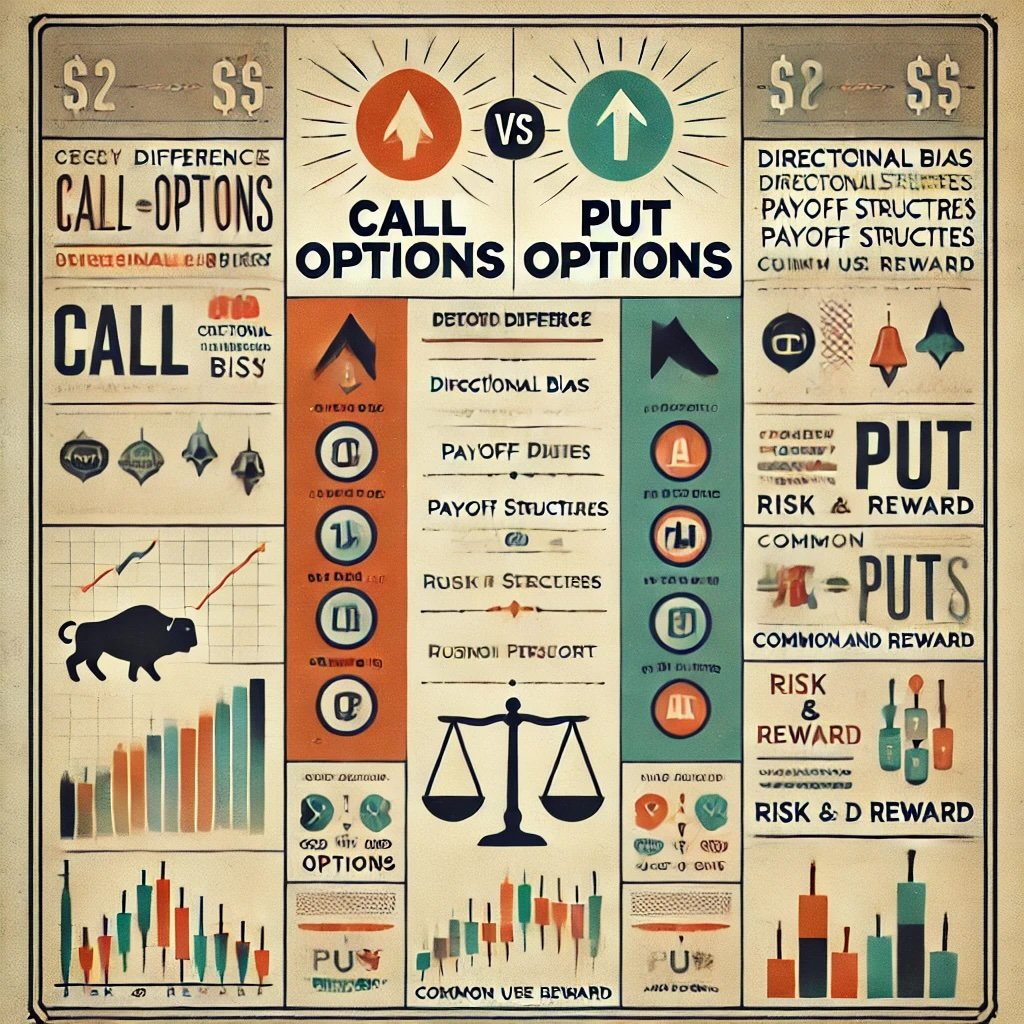
Key Differences Between Calls and Puts
While calls and puts are each “options,” they represent opposite stances on an underlying asset’s direction. Calls generally align with bullish or upward expectations, whereas puts represent a stance that either expects downward movement or wants protection against declines. Let’s recap the differences in a structured manner.
Opposite mirrors of each other.
1. Directional Bias
- Calls:
- Bullish.
- The call buyer profits if the underlying price climbs above the strike plus the paid premium.
- The call writer is obligated to deliver shares at the strike if assigned, risking losses if the underlying soars.
- Puts:
- Bearish.
- The put buyer profits if the underlying price falls below the strike minus the paid premium.
- The put writer must buy shares at the strike if assigned, risking losses if the underlying plunges.
2. Payoff Structures
- Call Buyer:
- Pays premium upfront.
- Upside is theoretically unlimited (the underlying could keep rising).
- Downside limited to the premium if the underlying never surpasses the strike by enough to be worthwhile.
- Put Buyer:
- Pays premium upfront.
- Gains if the underlying drops significantly below the strike; maximum potential if the stock goes to zero.
- Downside limited to premium if the underlying remains above the strike.
Premium = cost, payoff = direction.
3. Risk and Reward
- Option Buyers (Both Calls and Puts):
- Risk: The premium (i.e., total cost).
- Reward: Potentially significant, depending on how far the underlying moves in favor of the position.
- Time Decay: An ongoing drag if the move doesn’t come quickly enough.
- Option Sellers (Both Calls and Puts):
- Collect premium.
- Potentially large or even unlimited risk (e.g., naked call writing can be disastrous if the stock jumps).
- Often done by those who expect the underlying not to move significantly or who want to generate income from stable stocks.
4. Common Use Cases
- Calls:
- Speculation: Going long calls when expecting a bullish breakout or strong rally.
- Covered Calls: Selling calls against owned stock to collect premium and possibly exit shares at a higher target.
- Bullish Spreads: Combining multiple calls at different strikes to shape risk-reward, like a bull call spread.
- Puts:
- Protection: Buying puts to hedge long stock positions, capping downside.
- Speculation: Anticipating a downside move.
- Cash-Secured Puts: Writing puts on a stock you’d like to buy at a lower price anyway, collecting premium in the meantime.
5. Emotional / Psychological Factor
- Calls:
- Typically evoke excitement about upward growth potential.
- A call buyer might be more optimistic about markets or the particular asset’s future.
- Puts:
- Often depict caution or negativity about the underlying’s prospects.
- A put buyer might be protecting gains or outright betting on a decline, requiring a contrarian or defensive mindset.
Calls = optimism, puts = caution.
Recognizing these differences cements an investor’s or trader’s capability to adopt the right instrument in line with their forecast. Yet, calls and puts can serve broader purposes beyond mere speculation. In the next section, we delve into various real-world uses—speculative, hedging, or income-focused—that calls and puts can facilitate in a well-rounded strategy.
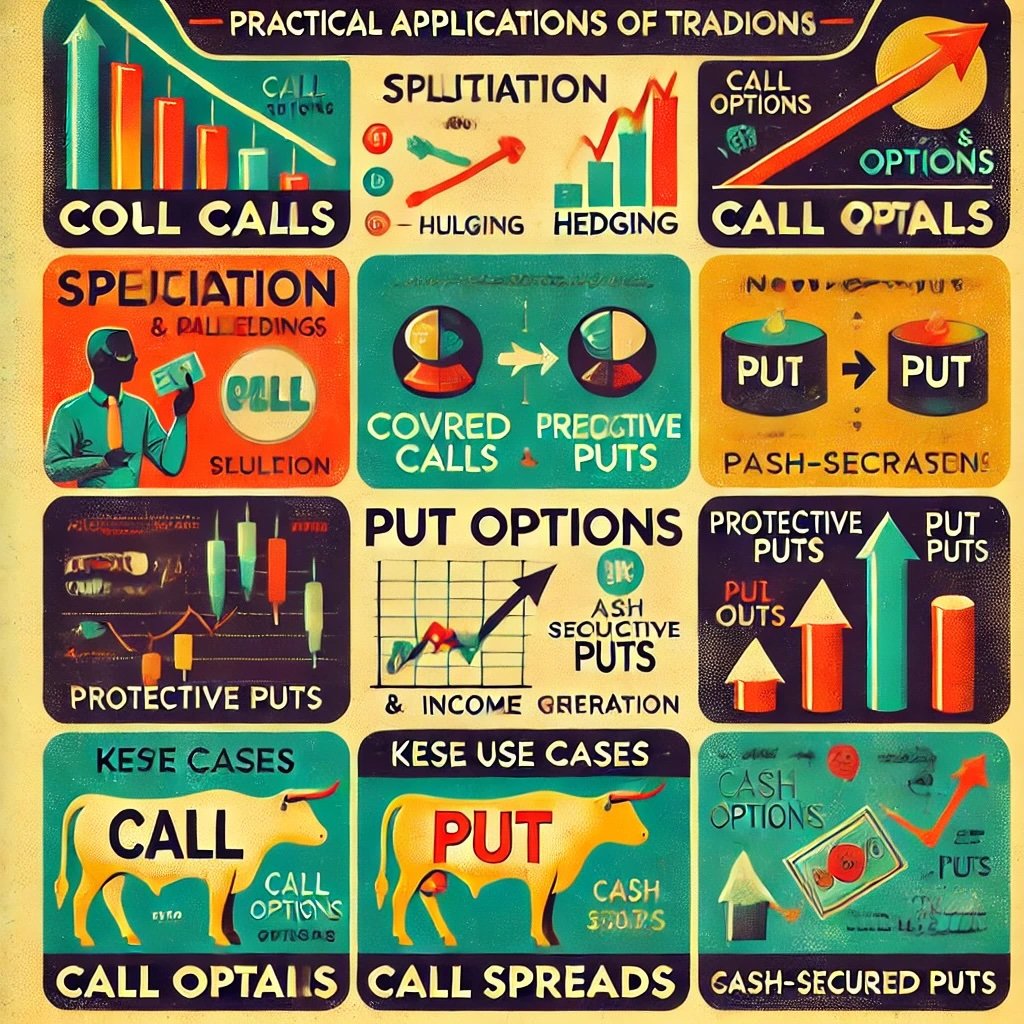
Practical Applications of Call and Put Options
Now that we’ve clarified how calls and puts individually function, let’s explore how they fit into the broader tapestry of trading and investing. Understanding these practical applications helps you see that options are not just about big or small directional bets; they’re also about shaping risk profiles, generating consistent returns, or insuring existing portfolios.
Theory meets practice.
1. Speculation
Using Calls for Bullish Bets
If you believe a particular stock or index will soon surge—perhaps due to strong upcoming earnings, a rumored merger, or a product launch—buying call options can yield high returns for limited capital:
- Leverage: You control more shares indirectly than if you bought the actual stock with the same capital.
- Limited Loss: If your bullish thesis fails, your maximum loss is the premium.
- Time Constraints: You need that surge to happen before expiration, so timing is everything.
Using Puts for Bearish Bets
If you suspect a major drop is on the horizon—whether from overvaluation, impending negative earnings, or macro risk—put options let you express that bearish view without short-selling:
- Limited Risk: You risk only the premium, unlike short-selling where an unexpected rally can cause theoretically infinite losses.
- Exponential Gains: A substantial drop can make your put deeply “in the money,” generating hefty returns relative to your outlay.
2. Hedging
Using Puts to Protect Long Positions
A classic use for puts is portfolio insurance. If you hold a significant position in a stock you like for the long term but fear a short-term downturn, buying a put can cap your downside:
- Example: Own 100 shares of ABC at $100. You buy a $95 put for $3. If ABC plummets to $80, your shares lose $20/share in value, but the put might gain around $15 of intrinsic value (minus premium), offsetting a large chunk of losses.
- Cost of Insurance: Repeatedly purchasing puts over multiple periods can add up, but it can be crucial to safeguard gains or mitigate market crashes.
Using Calls to Hedge Short Positions
Less common but still viable, if you’re short a stock and you’re worried about a short squeeze or unexpected positive news, you can buy calls as an “upside hedge.” This approach ensures that if the stock soars, your call’s gains offset some or all of your short position’s losses.
3. Income Generation
Covered Calls
An options writing technique: if you own shares of a stock (say 100 shares), you sell (write) a call against that position. By doing so, you collect premium upfront. If the stock remains below your call’s strike by expiration, the call expires worthless, and you keep both the shares and the premium. If the stock surpasses the strike, you might have to deliver your shares at that price, effectively capping your upside but monetizing your position:
- Advantages: Earn extra income from shares you already own, reduce cost basis if repeated over time.
- Disadvantages: If the stock soars well above the strike, you’ve limited your gains.
Get paid while holding.
Cash-Secured Puts
If you’d like to buy a stock at a lower price, writing (selling) a put can be a strategic approach:
- Setup: You sell a put at a certain strike, collecting a premium. You must keep enough cash in your account to buy the shares if assigned. If the stock stays above that strike, you keep the premium free and clear. If it dips below, you buy shares at the strike, effectively paying a discount thanks to the collected premium.
- Goals: It’s a method to acquire shares at a net lower cost or earn income if the stock never trades below the strike.
- Risks: If the stock plunges far below the strike, you still must buy at that strike, incurring a paper loss on those purchased shares.
4. Combining Strategies
Straddles, strangles, vertical spreads, iron condors—these more advanced setups often incorporate calls and puts in multiple ways, producing refined risk-reward profiles. For instance:
- Straddle: Buying a call and put at the same strike to exploit large moves, no matter the direction (covered in detail in another guide).
- Spreads: Pairing a bought call with a sold call at different strikes, or the same with puts, to offset costs.
- Iron Condors: Selling out-of-the-money puts and calls, forming a range-bound strategy if you believe the underlying won’t stray too far.
Limitless creativity with combos.
Essentially, mastering calls and puts isn’t just about straightforward directional speculation. The real artistry of options emerges when you blend them to match your precise forecast on both direction and volatility, or to systematically generate premium in different market conditions.
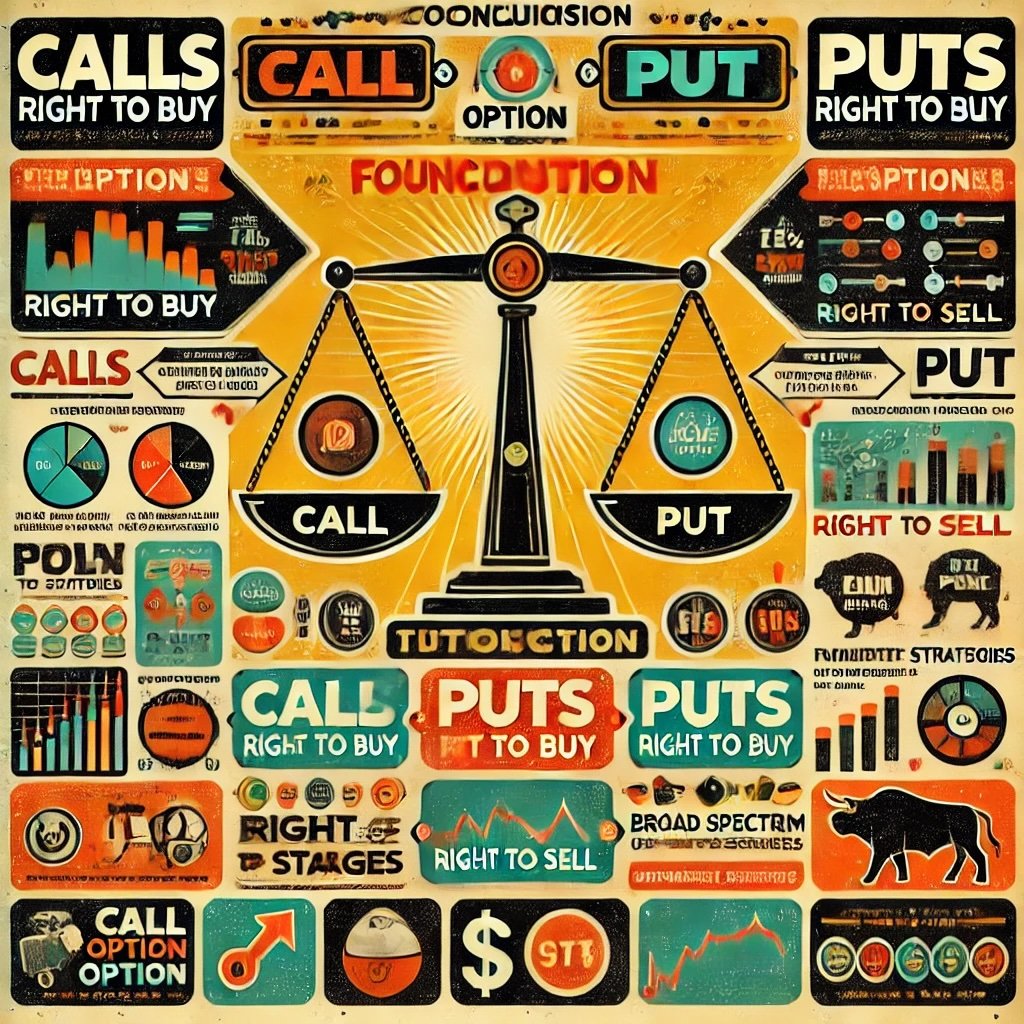
Call vs. Put Options: Understanding the Basics of Option Contracts — 12-Question FAQ
What is a call option?
A call gives the right (not obligation) to buy the underlying at the strike price on/before expiration. Buyers pay a premium; sellers receive it and may be assigned to sell shares at the strike.
What is a put option?
A put gives the right (not obligation) to sell the underlying at the strike price on/before expiration. Buyers pay a premium; sellers receive it and may be assigned to buy shares at the strike.
How do calls and puts differ in directional outlook?
Calls are generally bullish (benefit from rising prices). Puts are bearish (benefit from falling prices) or defensive (portfolio insurance against declines).
What determines an option’s price (premium)?
Premium = Intrinsic value (how much it’s in-the-money) + Extrinsic value (time value + implied volatility + rates/dividends). More time and higher IV usually mean higher premiums.
What do “in-the-money,” “at-the-money,” and “out-of-the-money” mean?
Call: ITM if price > strike; ATM if ≈ strike; OTM if price < strike.
Put: ITM if price < strike; ATM if ≈ strike; OTM if price > strike.
ITM options have intrinsic value; OTM are all time value.
How does time decay (theta) affect options?
All else equal, options lose value as expiration approaches. Near-dated, ATM options decay fastest. If price doesn’t move your way fast enough, a long option can still lose money.
What is implied volatility (IV) and IV crush?
IV reflects the market’s expected movement. Higher IV → higher premiums. After known events (e.g., earnings), IV often drops (“IV crush”), hurting long options if the actual move is smaller than priced in.
How do I choose strike and expiration?
Strike: Closer to current price = higher cost, higher sensitivity. Further OTM = cheaper but needs bigger move.
Expiration: Near-term = cheaper, faster decay, event-focused; longer-dated = pricier, more time and vega.
What are common ways to use calls and puts?
Speculation: Long calls (bullish), long puts (bearish).
Hedging: Long puts to protect long stock; calls to cap risk on shorts.
Income: Covered calls (own shares, sell calls) and cash-secured puts (set buy-price, collect premium).
What are the risks for buyers vs. sellers?
Buyers: Max loss is premium; risk of time decay/IV crush.
Sellers (naked): Potentially large or unlimited risk (e.g., short calls if stock surges). Many sellers keep risk-defined (covered calls, cash-secured puts, vertical spreads).
American vs. European exercise—does it matter?
American options can be exercised anytime up to expiration; European only at expiration. U.S. equity options are typically American-style; many index options are European-style, affecting early-exercise and assignment risk.
What are typical beginner mistakes to avoid?
Buying near expiration without a catalyst, chasing far-OTM “lottery” calls/puts, ignoring IV levels, oversizing because “max loss is only the premium,” and trading without a plan for exits and risk limits.
Conclusion
Calls and puts are the bedrock of the options universe. Each contract type grants distinct rights: a call allows you to buy the underlying at the strike price; a put grants you the right to sell at the strike. From these simple building blocks, traders, investors, and institutions craft an impressive spectrum of strategies—ranging from the straightforward (buying a call in anticipation of a rally) to the nuanced (deploying an iron condor for range-bound markets).
Basics unlock advanced potential.
Recap
- Calls:
- Ideal for bullish stances or capturing upside on a stock you believe could climb.
- Premium is your total risk, but potential profits can multiply if the underlying surges above your strike plus the premium cost.
- Used for leverage, speculation, or generating covered call income.
- Puts:
- Tailored for bearish outlooks or hedging existing longs.
- Buyer can profit when the underlying falls, covering the difference below the strike minus the paid premium.
- A key tool for insurance and downside protection (e.g., protective puts), or a direct bet on a stock’s decline.
- Straddle of Differences:
- Calls vs. puts revolve around up vs. down.
- Each side can be bought or sold, depending on your objective—profiting from directional moves or collecting premium if you believe the market will defy the buyer’s expectations.
Managing Risk
While calls and puts offer controlled risk (the premium paid, if you’re a buyer), the temptation to over-leverage is very real. Time decay, implied volatility changes, and incorrect timing can swiftly erode option premium. Thus, risk management techniques—like picking the correct strike, suitable expiration, or well-defined exits—remain paramount. If you choose to sell options, the risks can balloon if not hedged, especially for naked calls.
Risk is real, plan carefully.
Embracing Options for Portfolio Enrichment
Seasoned investors and novices alike can benefit from at least a basic command of calls and puts. A long-only equity investor might incorporate puts to shield gains, or covered calls for incremental income. A momentum trader might harness calls to magnify bullish convictions, while a macro speculator might tap puts to profit from a market downturn. Indeed, the realm of possibility expands dramatically once you shift from plain stock picks to options-based solutions.
Yet, it’s also vital to remember that options are not a magical remedy for sloppy analysis. If your underlying assumption about a stock’s direction or volatility proves flawed, the option’s ephemeral nature ensures losses can unfold promptly. This highlights the ongoing necessity of thorough research, prudent position sizing, and strategic planning.
Skill and discipline matter.
Final Thoughts
Learning calls and puts is akin to grasping the alphabet of options trading—once you can read these letters, you can form more intricate “words” and “sentences” in your trading language. Whether your priority is leveraging small capital to chase big gains, insuring an equity portfolio from tail risks, or generating a consistent stream of premium-based income, calls and puts are the essential foundation. By respecting time decay, implied volatility, and basic risk management principles, you can harness the dynamism of options to complement or even transform your investing approach.
Important Information
Comprehensive Investment Disclaimer:
All content provided on this website (including but not limited to portfolio ideas, fund analyses, investment strategies, commentary on market conditions, and discussions regarding leverage) is strictly for educational, informational, and illustrative purposes only. The information does not constitute financial, investment, tax, accounting, or legal advice. Opinions, strategies, and ideas presented herein represent personal perspectives, are based on independent research and publicly available information, and do not necessarily reflect the views or official positions of any third-party organizations, institutions, or affiliates.
Investing in financial markets inherently carries substantial risks, including but not limited to market volatility, economic uncertainties, geopolitical developments, and liquidity risks. You must be fully aware that there is always the potential for partial or total loss of your principal investment. Additionally, the use of leverage or leveraged financial products significantly increases risk exposure by amplifying both potential gains and potential losses, and thus is not appropriate or advisable for all investors. Using leverage may result in losing more than your initial invested capital, incurring margin calls, experiencing substantial interest costs, or suffering severe financial distress.
Past performance indicators, including historical data, backtesting results, and hypothetical scenarios, should never be viewed as guarantees or reliable predictions of future performance. Any examples provided are purely hypothetical and intended only for illustration purposes. Performance benchmarks, such as market indexes mentioned on this site, are theoretical and are not directly investable. While diligent efforts are made to provide accurate and current information, “Picture Perfect Portfolios” does not warrant, represent, or guarantee the accuracy, completeness, or timeliness of any information provided. Errors, inaccuracies, or outdated information may exist.
Users of this website are strongly encouraged to independently verify all information, conduct comprehensive research and due diligence, and engage with qualified financial, investment, tax, or legal professionals before making any investment or financial decisions. The responsibility for making informed investment decisions rests entirely with the individual. “Picture Perfect Portfolios” explicitly disclaims all liability for any direct, indirect, incidental, special, consequential, or other losses or damages incurred, financial or otherwise, arising out of reliance upon, or use of, any content or information presented on this website.
By accessing, reading, and utilizing the content on this website, you expressly acknowledge, understand, accept, and agree to abide by these terms and conditions. Please consult the full and detailed disclaimer available elsewhere on this website for further clarification and additional important disclosures. Read the complete disclaimer here.




